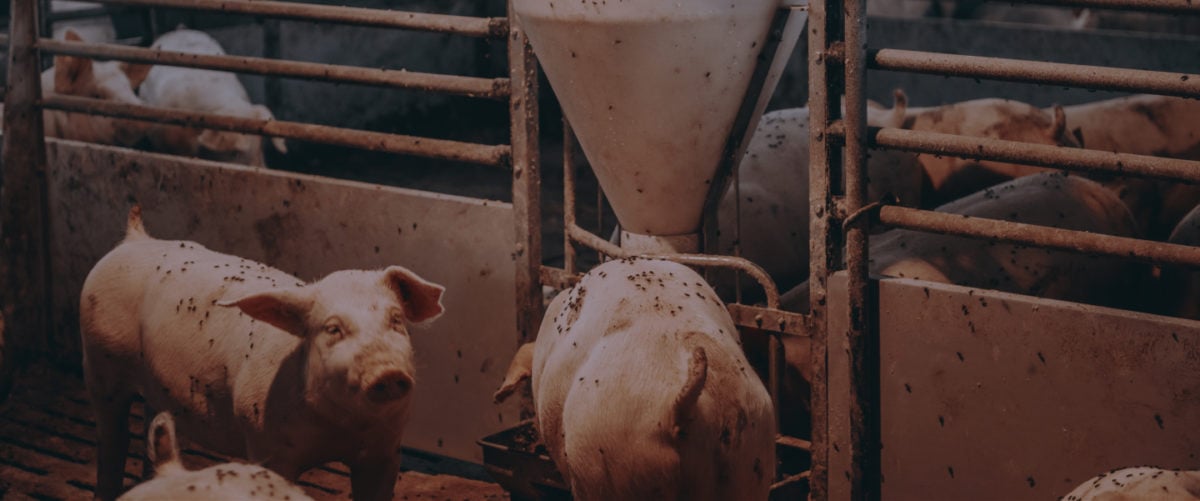Why Did The EPA Give Factory Farms A Free Pass With Air Pollution?
Published Nov 9, 2021

The EPA struck a deal with thousands of factory farms in 2005, giving them a temporary pass from their Clean Air Act obligations. Why is it still in place?
The Biden administration talks a big game when it comes to protecting the environment. On his first day in office, President Biden signed an executive order to hold polluters accountable for toxic air pollution. Unfortunately, these policies don’t seem to apply to Big Ag. When it comes to factory farm pollution, Biden’s EPA has quietly preserved a George W. Bush-era policy that does the opposite. It continues a corrupt amnesty deal for factory farms that shields them from complying with federal air pollution laws.
Enough is enough. As part of a coalition of advocacy organizations, we recently called the Administration out on its hypocrisy. On October 26, we filed a legal petition with EPA urging it to end this 16-year-old amnesty agreement. They must enforce our clean air laws against this major polluting industry.
Factory Farm Air Pollution Kills Thousands of People Every Year in the U.S.
This decades-long amnesty has had far-reaching consequences for public health and the environment. Factory farms emit deadly air pollutants like ammonia, hydrogen sulfide, particulate matter, volatile organic compounds, and climate-warming methane. They put nearby residents — often low-income communities of color — at risk for serious illnesses, like asthma and pneumonia.
Even worse, the livestock industry’s air pollution is responsible for over 12,700 deaths per year. That’s more deaths than are attributed to coal-fired power plants. That means over 200,000 lives have been lost due to this industry’s air pollution since 2005.
Despite Serious Threat To Public Health, EPA Has Given Factory Farms a Free Pass To Pollute Since 2005
In 2005, the George W. Bush administration announced an agreement it had secretly negotiated with the pork lobby. EPA would refrain from enforcing key air pollution control and public transparency laws like the Clean Air Act against animal feeding operations (AFO) that signed up for the deal. In exchange, the AFOs agreed to pay a small fee to fund a nationwide air monitoring program to help EPA develop more accurate air emissions estimating methodologies (EEMs) for AFOs. These were supposed to help calculate factory farms’ pollution so clean air law enforcement could finally begin.
At the time, environmentalists challenged the legality of this agreement, arguing it was an abdication of EPA’s enforcement authority. However, the D.C. Circuit Court allowed EPA to proceed. Their decision partly relied on the agency’s assurances that the “limited” deferral would last no longer than three and half years.
Nearly 14,000 AFOs nationwide signed up for this sweetheart deal. By EPA’s own estimate, this accounted for over 90 percent of the country’s largest factory farms. The industry has grown significantly since 2005, but EPA has used the agreement as an excuse not to regulate the industry at large until it develops accurate EEMs.
EPA Dropped The Ball, Exposing Communities To Air Pollution
EPA promised to complete the air monitoring study, develop emission models, and end the Air Consent Agreement by 2010. But a series of agency missteps and delays means EPA has yet to finalize any methodologies or end the agreement.
From the start, fundamental problems plagued the emission methodologies development process. From how EPA designed and ran the study, to how it attempted to use the data, it was a mess. For instance, close to 14,000 AFOs signed the Air Consent Agreement. But EPA selected just 20 AFOs in 10 states to study, an incredibly small, and non-representative industry sample. This, along with equipment failures and other technical problems, limited EPA’s ability to develop accurate emission models.
When EPA used this compromised data to develop draft methodologies, the drafts were deemed utterly unusable by the scientific community. Even EPA’s own Science Advisory Board lambasted the emission models. It concluded they were unfit for national use, and incapable of predicting emissions beyond the small number of farms studied. In short — garbage in, garbage out.
After that, EPA efforts completely stalled. It wasn’t until 2017, when EPA’s Office of Inspector General criticized EPA for its inaction, that the development process restarted. But this revived process hasn’t fared any better. Now, after nearly five more years of delay, EPA has still not finalized any methodologies. It has largely ignored advice it received from its Science Advisory Board about how to produce accurate emission models.
Meanwhile, thousands of AFOs enjoy protection from EPA enforcement indefinitely, even if their emissions exceed legal limits or reporting thresholds. EPA’s unwillingness to cross Big Ag is the same under Biden, and people are paying with their health and their lives.
EPA’s Inaction Is Unacceptable And Must End Now
AFO air pollution has serious and unregulated public health impacts. We are demanding EPA put a stop to its unacceptable dereliction of duty. It must terminate the Air Consent Agreement, and take all actions consistent with President Biden’s executive orders to enforce applicable clean air laws against AFOs.
The agency never should have granted this amnesty in the first place. After nearly twenty years of this mistake, it absolutely must put an end to this perpetual license to pollute.
Your friends need to know about this, too.
Enjoyed this article?
Sign up for updates.
TO TOP


